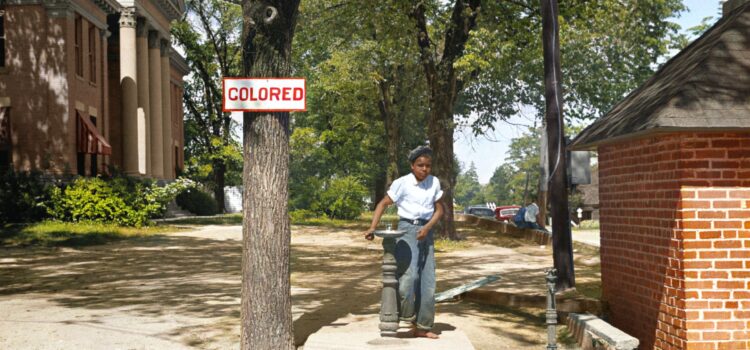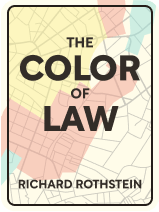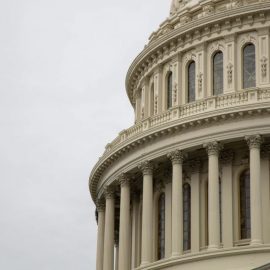

This article is an excerpt from the Shortform book guide to "The Color of Law" by Richard Rothstein. Shortform has the world's best summaries and analyses of books you should be reading.
Like this article? Sign up for a free trial here .
What is the main argument of The Color of Law book? Why are the policies of the government primarily responsible for racial residential segregation?
The main argument of The Color of Law book is that the racial residential segregation of African Americans is a direct result of unconstitutional, discriminatory government policy and not due to personal choices. Past government actions like segregated public housing, exclusionary zoning laws, and racial discrimination by federal agencies laid the foundation for residential segregation.
Read on to discover how The Color of Law book highlights the central role of public policy in residential segregation.
The Main Argument of The Color of Law Book
Richard Rothstein’s The Color of Law argues that racial residential segregation—the fact that some neighborhoods are almost exclusively African American while others are almost exclusively white—is the result of explicit government policy rather than personal choice. In other words, racial residential segregation in the United States is de jure (“by law”) rather than de facto (in this context, “by virtue of personal choices or random circumstances”). The distinction between de jure and de facto segregation is paramount, because de jure segregation is unconstitutional: It infringes the Fifth, Thirteenth, and Fourteenth Amendments to the Constitution.
Each section in The Color of Law book covers a specific way in which racial residential segregation was realized, from the segregation of public housing to labor-market discrimination.
(A note on terminology: Rothstein uses “Black” and “African American” interchangeably, and refers purposefully to “ghettos.” A “ghetto” describes a residential area with a concentrated minority, a shortage of opportunity, and significant barriers to exit. These three conditions apply to contemporary African American neighborhoods.)
Public Housing as a Segregating Agent
One of the most important methods by which government segregated cities was the construction of segregated public housing (“projects”) from World War I through to the 1960s and 1970s. By confining African Americans to subpar public housing in undesirable areas, federal, state, and local authorities promoted the (1) segregation of their cities and (2) the transformation of predominantly Black areas into slums.
Projects were segregated as a matter of policy. For example, they had to abide by the “neighborhood composition rule”—that is, they had to reflect the racial composition of the neighborhood around them.
During WWII, segregated projects were constructed near shipyards to house the influx of war workers. Black workers were housed close to worksites in shoddily constructed units, while white workers lived in sturdier projects further inland. (White workers were also subsidized to rent rooms from private landlords.)
After WWII, city-level public housing authorities used segregated public housing to ghettoize their African American residents. For example, in 1952, the NAACP took the San Francisco public housing authority to court, claiming that though the authority had promised to make all new construction integrated, it was trying to build a new segregated project. Under oath, the authority’s chairman admitted that the agency was purposely trying to confine African Americans to particular locations in the city.
Exclusionary Zoning Laws
Another key cause of racial residential segregation in the US according to The Color of Law book was the enactment of discriminatory zoning laws. Zoning laws are local ordinances that limit how certain “zones”—or areas—in a municipality can be developed; racial zoning laws restricted African Americans from owning property in certain areas.
After the Supreme Court ruled racial zoning unconstitutional in Buchanan v. Warley, city authorities found workarounds and subterfuges that allowed them to continue segregating by race. Two such strategies were:
1) Economic Zoning
Officials passed ordinances limiting certain neighborhoods to single-family homes affordable only to middle-income people. Because African Americans had been historically and systematically discriminated against in the job market, many were lower-income and so could only afford housing in apartment buildings—structures that were banned by these ordinances. The result was that areas zoned for single-family homes stayed or became white while areas that allowed multiple-family dwellings stayed or became African American.
2) Industrial Zoning
Certain areas in municipalities are zoned specifically for industry to protect residents from nuisances like noise and air pollution. To further segregate their cities in the wake of Buchanan, city officials zoned areas near predominantly Black neighborhoods for industry. This move lowered property values in those areas, thereby reducing the current residents’ wealth and limiting their opportunities to move out.
An example of this method can be seen in South Central Los Angeles, a predominantly Black area. In the 1940s, the city began using “spot” rezoning ordinances to move automobile junkyards and commercial factories into the area, thus ghettoizing the residents.
Federal Loan Discrimination
The shortcoming of economic zoning—at least as far as segregationists were concerned—was that it was race-blind: If a Black family were wealthy enough, they could live in an economically zoned neighborhood. In order to keep African Americans confined to particular neighborhoods, the federal government pursued a two-pronged approach. First, it appraised areas that were majority African American as “risky” (a process known as “redlining”); then it denied loan guarantees and financial support to Black families attempting to live outside those areas.
The agency doing the denying was the Federal Housing Administration (“FHA”). Created to increase home ownership by insuring private bank mortgages and facilitating more advantageous terms, the FHA systematically discriminated against Black families. Their reasoning was that integration led to a “reduction in [property] values.”
The Failures of The IRS and Other Government Agencies
The Color of Law book also explains how many other federal agencies besides the FHA contributed to racial residential segregation. The IRS, the FDIC, and the Federal Reserve all, in one way or another, exacerbated it.
One of the central responsibilities of the IRS is determining the tax-exempt status of various US entities. Although its rules require the agency to withhold tax exemptions from organizations that countermand official public policy or promote prejudice and discrimination, the IRS regularly conferred tax-exempt status on entities that contributed to racial residential segregation. For example, tax-exempt religious entities like churches and synagogues regularly promoted segregationist policies like racial restrictive covenants.
Tax-exempt colleges, too, promoted segregation. The University of Chicago subsidized local property owners so that they could keep Hyde Park and its surrounds segregated. From 1933 to 1947, the University covered $100,000 in legal fees for the defense of restrictive covenants and the eviction of recently arrived African Americans.

———End of Preview———
Like what you just read? Read the rest of the world's best book summary and analysis of Richard Rothstein's "The Color of Law" at Shortform .
Here's what you'll find in our full The Color of Law summary :
- How racial residential segregation is the result of explicit government policy
- The three reasons why racial segregation is so difficult to reverse
- The steps that could lead to a more integrated and equitable society






